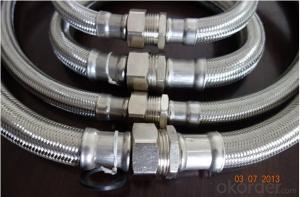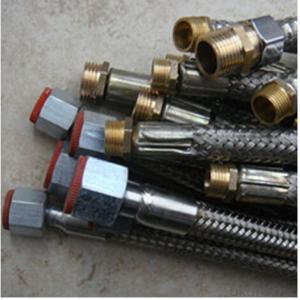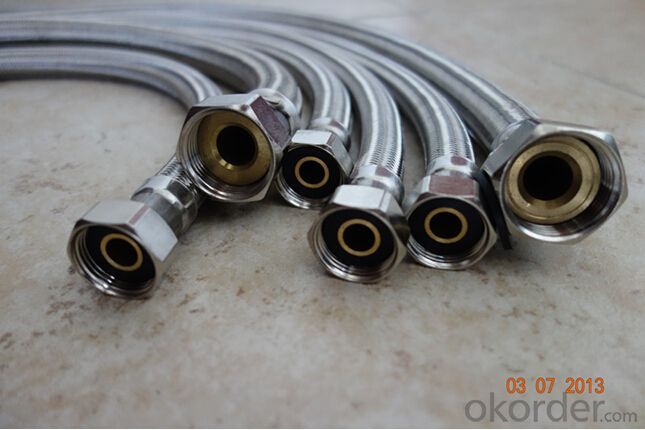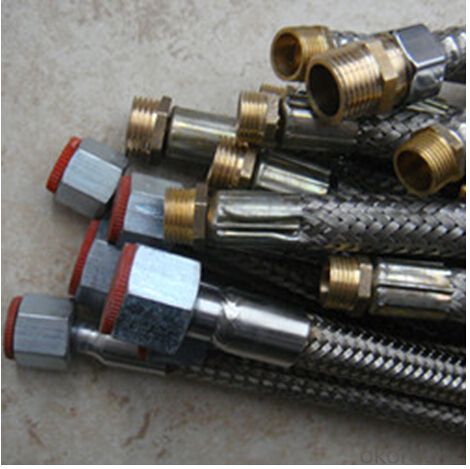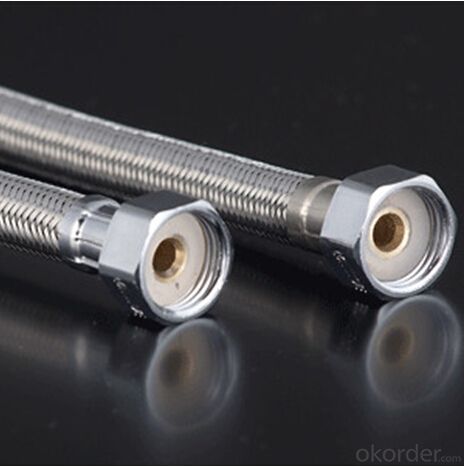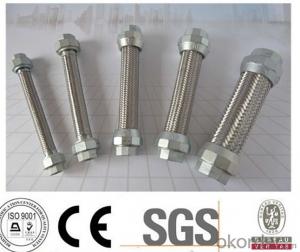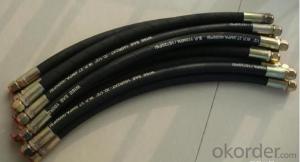Metal Braided Hose for Industrial and Building
- Loading Port:
- Tianjin
- Payment Terms:
- TT OR LC
- Min Order Qty:
- 1000 pc
- Supply Capability:
- 100000 pc/month
OKorder Service Pledge
OKorder Financial Service
You Might Also Like
Specification
Metal Braided Hose for Industrial and Building
Applications of Metal Braided Hose for Industrial and Building:
--Refueling system
--Chemical and pharmaceutical industry
--Industrial hydraulic systems
--Air conditioners in industrial and construction –site vehicles
--Food and beverage industry
--Special and standard industrial applications
--Water and cleaning management
Features of Metal Braided Hose for Industrial and Building:
1. )O. D.: 13-18MM 0.2-3M long
2. )Nut.: Nickel/Chrome Plated Brass (Zinc / Iron / Aluminum is available)
3. )Size Of Nut.: Female&Male 1/2''; 3/4''; 3/8''; 7/8''; 5/16'', and M10...
4. )Insert.: Brass (Zinc / Aluminum / Plastic is available)
5. )Inner tube.: Rubber/ EPDM/PVC
6. )Covered Material: Stainless Steel 201, 301, 304 /Aluminium Wire
7. )Working Pressure: 5Kg-15Kg
8. )Temperature: 0-92° C
9. )Quality Assurance: 3 years
RemarkAPPLICATION: HOUSEEHOLD WARE, BATHROOM WARE, SHOWER HOSE
PAYMENT: T/T, L/C
DELIVERY TIME: 20DAYS OR 30DAYS AFTER RECEIVED 30% DEPOSITS
MOQ: 5000PCS
ODM&OEM IS ACCEPTABLE
PackageInner: PP bag /Blister packing Outer: Carton box
Specifications of Metal Braided Hose for Industrial and Building:
NO | I.D | Refer to O.D | Working pressure | Burst pressure | approximate Weight | |||||
(inch) | (mm) | (inch) | (mm) | MPa | Psi | MPa | Psi | kg/m | lbs/ft | |
1 | 1/8 | 3.2±0.2 | 0.35 | 9±0.3 | 2.06 | 300 | 8.27 | 1200 | 0.078 | 0.12 |
2 | 5/32 | 4±0.2 | 0.4 | 10±0.3 | 2.06 | 300 | 8.27 | 1200 | 0.092 | 0.14 |
3 | 3/16 | 4.8±0.2 | 0.43 | 11±0.3 | 2.06 | 300 | 8.27 | 1200 | 0.108 | 0.16 |
4 | 1/4 | 6.3±0.3 | 0.5 | 12.7±0.3 | 2.06 | 300 | 8.27 | 1200 | 0.134 | 0.2 |
5 | 5/16 | 8.0±0.3 | 0.56 | 14±0.3 | 2.06 | 300 | 8.27 | 1200 | 0.147 | 0.22 |
6 | 3/8 | 9.5±0.3 | 0.63 | 16±0.4 | 2.06 | 300 | 8.27 | 1200 | 0.182 | 0.27 |
7 | 15/32 | 12±0.3 | 0.75 | 19±0.5 | 2.06 | 300 | 8.27 | 1200 | 0.238 | 0.35 |
8 | 1/2 | 12.7±0.4 | 0.78 | 20±0.5 | 2.06 | 300 | 8.27 | 1200 | 0.262 | 0.39 |
9 | 5/8 | 16±0.4 | 0.94 | 24±0.5 | 1.03 | 150 | 4.12 | 600 | 0.351 | 0.52 |
10 | 3/4 | 19±0.4 | 1.13 | 28.8±0.5 | 1.03 | 150 | 4.12 | 600 | 0.515 | 0.77 |
11 | 1 | 25.4±0.5 | 1.38 | 35±0.6 | 1.03 | 150 | 4.12 | 600 | 0.637 | 0.95 |
Images of Metal Braided Hose for Industrial and Building:
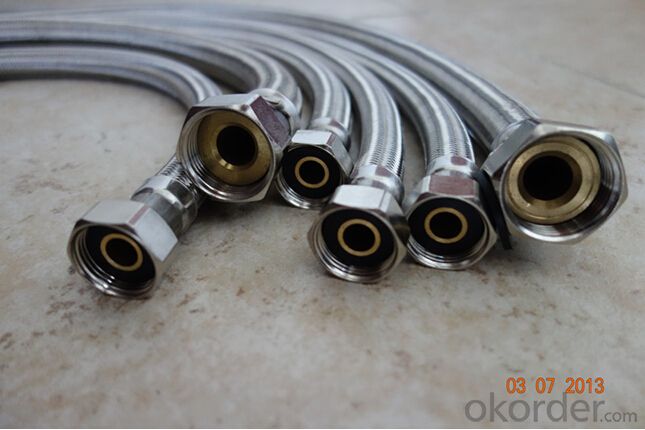
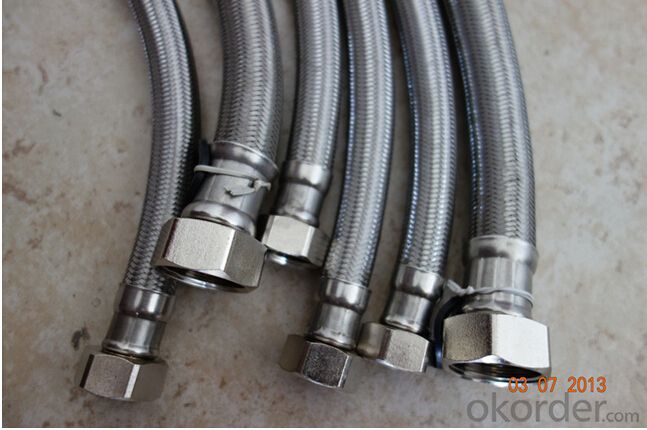
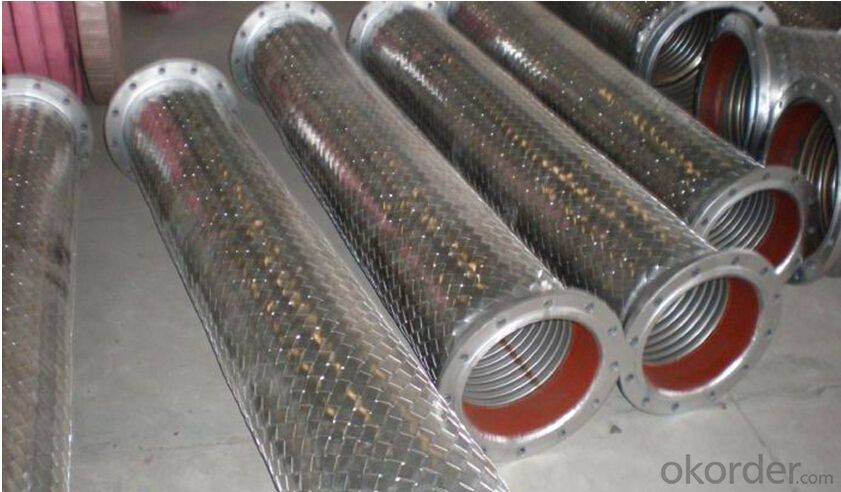
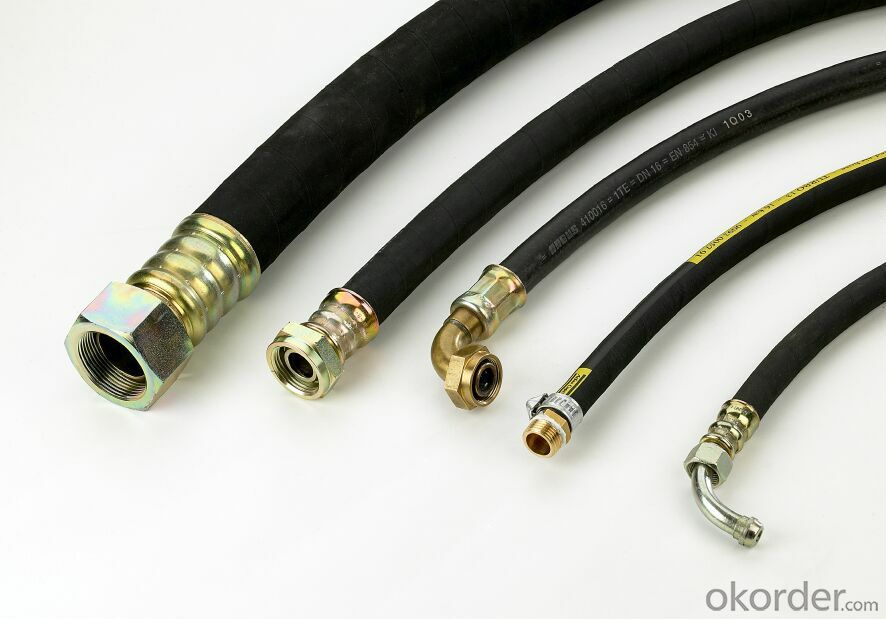
Package of Metal Braided Hose for Industrial and Building:
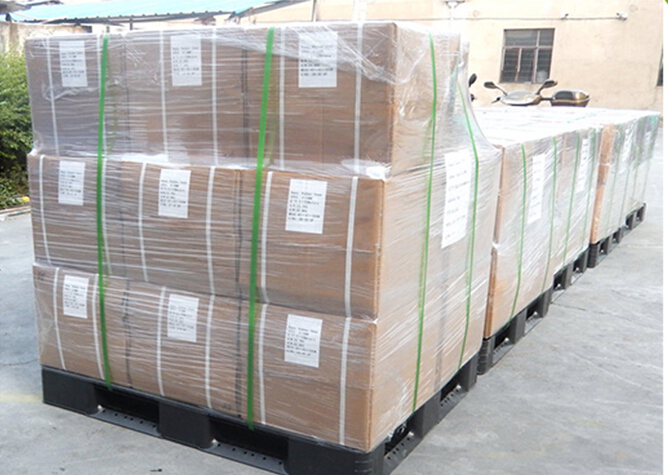
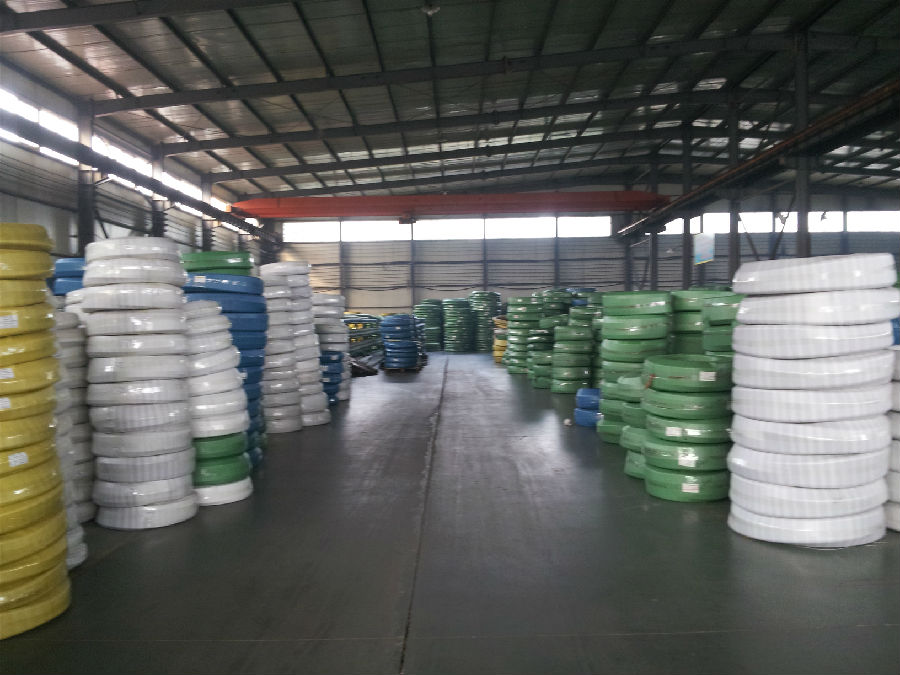
FAQ of Metal Braided Hose for Industrial and Building:
Who we are:
Answer: We CNBM is a Chinese state-owned enterprise ranked 267th among the Global Fortune 500, as the largest building materials company,we have over 300 affiliated companies,and so many production lines and branch office distribute in China.
2. About our quality:
Answer: Every product needs to be quality proved before shipping.
3. About our service:
Answer: We could gurantte that we can reply you in 2 working hours.
- Q: What brand of stainless steel pipe cutting machine is good?
- Stainless steel cutting pipe should take into account the cutting speed, accuracy, cross section flatness, surface scratches, cutting tool loss and so on
- Q: 304 stainless steel will rust it?
- Stainless steel is a very thin layer formed on the surface and the stability of the fine solid chromium rich oxide film (protective film), to prevent the infiltration of oxygen atoms, to oxidation, and the ability to obtain anti-corrosion. Once there are some reasons, this film was constantly destroyed, air or liquid oxygen atoms will continue to infiltrate or metal atoms of iron to keep out from the loose formation of iron oxide, the metal surface will be continuously corroded.
- Q: How are stainless steel pipes graded?
- Stainless steel pipes are graded based on their composition, strength, and corrosion resistance. The grading system, commonly known as the "SAE steel grades," categorizes stainless steel pipes into different series such as 200, 300, and 400 series. These grades are determined by the amount of chromium and nickel present in the steel, which enhances its resistance to corrosion. Additionally, stainless steel pipes can also be classified by their dimensions, specifications, and designated applications.
- Q: What is the difference between 409 and 316 stainless steel pipes?
- The composition and intended use are what differentiate 409 and 316 stainless steel pipes. 409 stainless steel is categorized as ferritic stainless steel, containing more chromium but less nickel than 316 stainless steel. This means that 409 stainless steel is less resistant to corrosion and oxidation. However, it is still suitable for applications that require moderate levels of corrosion resistance, such as automotive exhaust systems and heat exchangers. On the contrary, 316 stainless steel is classified as austenitic stainless steel, with higher amounts of both chromium and nickel. Because of its composition, it provides excellent corrosion resistance, even in demanding environments. Therefore, it is commonly used in applications where superior resistance to corrosion is necessary, such as marine environments, chemical processing plants, and medical equipment. To summarize, the main distinctions between 409 and 316 stainless steel pipes are their composition and corrosion resistance. 409 stainless steel is appropriate for applications with moderate levels of corrosion resistance, while 316 stainless steel is the preferred choice for applications that demand superior corrosion resistance in harsh environments.
- Q: Are stainless steel pipes suitable for marine applications?
- Yes, stainless steel pipes are suitable for marine applications. Stainless steel is highly resistant to corrosion and can withstand the harsh conditions of saltwater, making it a popular choice for marine applications such as shipbuilding, offshore structures, and marine equipment. It provides excellent durability, strength, and long-term performance in marine environments.
- Q: What is the difference between 304J2 and 316J2 stainless steel pipes?
- The main difference between 304J2 and 316J2 stainless steel pipes lies in their chemical composition. While both alloys contain the base elements iron and carbon, 304J2 stainless steel pipes have a higher concentration of chromium and nickel, while 316J2 stainless steel pipes have a higher concentration of chromium, nickel, and molybdenum. This makes 316J2 stainless steel pipes more resistant to corrosion, especially in environments with chloride ions, such as saltwater or marine applications. Additionally, 316J2 stainless steel pipes have better heat resistance and are more suitable for high-temperature applications.
- Q: How do stainless steel pipes compare to polyvinyl chloride pipes?
- Stainless steel pipes and polyvinyl chloride (PVC) pipes are two popular options for plumbing and other industrial applications. They have distinct characteristics and advantages, making them suitable for different purposes. Firstly, stainless steel pipes are known for their exceptional durability and strength. They are highly resistant to corrosion, rust, and extreme temperatures, making them ideal for harsh environments and outdoor applications. Additionally, stainless steel pipes have a long lifespan and require minimal maintenance, reducing replacement and repair costs over time. On the other hand, PVC pipes are lightweight and easy to install, making them a cost-effective option for both residential and commercial plumbing systems. They are resistant to chemicals and offer good insulation properties. PVC pipes are also non-conductive, making them suitable for electrical applications. Moreover, PVC pipes are typically less expensive than stainless steel pipes, which can be a determining factor for budget-conscious projects. Another crucial aspect to consider is the environmental impact. Stainless steel pipes are fully recyclable, making them an environmentally friendly choice. PVC pipes, however, can pose environmental concerns due to the use of chlorine during production and the difficulty in recycling. Ultimately, the choice between stainless steel pipes and PVC pipes depends on various factors, such as the specific application, budget, durability requirements, and environmental considerations. While stainless steel pipes excel in terms of durability and resistance, PVC pipes are cost-effective and easy to install. It is essential to evaluate the needs of the project and consult with professionals to determine the most suitable option for each specific case.
- Q: Can stainless steel pipes be used in drinking water systems?
- Yes, stainless steel pipes can be used in drinking water systems. Stainless steel is a highly durable and corrosion-resistant material that can withstand the harsh elements present in water systems. It does not leach any harmful substances into the water, making it a safe choice for drinking water applications. Additionally, stainless steel pipes are easy to clean and maintain, further ensuring the quality and safety of the drinking water.
- Q: Are stainless steel pipes resistant to UV radiation?
- UV radiation does not affect stainless steel pipes as they are resistant to it. Stainless steel is renowned for its exceptional ability to resist corrosion, including the harmful impacts of UV radiation. When exposed to UV radiation, stainless steel develops a passive oxide layer on its surface, which acts as a shield to prevent further harm. This oxide layer effectively prevents degradation, discoloration, and loss of mechanical properties that can arise from exposure to UV radiation. Consequently, stainless steel pipes are an ideal option for outdoor or exposed uses where UV radiation is a concern.
- Q: What are the different grades of stainless steel used for pipes?
- There are several different grades of stainless steel that are commonly used for pipes, each with their own unique properties and characteristics. The most common grades include: 1. Grade 304: This is the most widely used stainless steel grade for pipes. It offers excellent corrosion resistance, high-temperature strength, and good formability. It is commonly used for both indoor and outdoor applications, such as water supply pipes, food processing equipment, and architectural structures. 2. Grade 316: This grade is similar to 304 but contains a higher content of molybdenum, which enhances its corrosion resistance, especially against chlorides and other corrosive chemicals. It is commonly used in marine environments, chemical processing plants, and medical equipment. 3. Grade 321: This grade contains titanium, which stabilizes it against sensitization during welding or high-temperature exposure. It offers excellent resistance to oxidation and can be used in applications where high temperatures are involved, such as exhaust systems and boilers. 4. Grade 409: This grade is commonly used for pipes in automotive exhaust systems due to its excellent heat resistance and durability. It is also resistant to corrosion from road salts and other harsh chemicals. 5. Grade 347: Similar to grade 321, this grade contains niobium, which provides additional stabilization against sensitization. It is commonly used in high-temperature applications where resistance to intergranular corrosion is required, such as in aircraft and jet engine components. These are just a few examples of the different grades of stainless steel used for pipes. The specific grade chosen for a particular application depends on factors such as the environment, temperature, corrosion resistance requirements, and mechanical properties needed.
Send your message to us
Metal Braided Hose for Industrial and Building
- Loading Port:
- Tianjin
- Payment Terms:
- TT OR LC
- Min Order Qty:
- 1000 pc
- Supply Capability:
- 100000 pc/month
OKorder Service Pledge
OKorder Financial Service
Similar products
Hot products
Hot Searches
Related keywords

